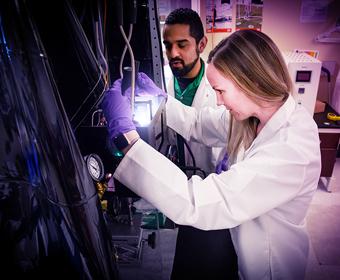New ATFs will limit overheating and reduce risk of radioactive leaks

Credit: Courtesy of UTSA
(San Antonio, Feb. 27, 2019) – Almost eight years have passed since the accident at the nuclear power plant in Fukushima, Japan, and thousands of residents have yet to return to their homes. Now the U.S. Department of Energy (DOE) has tapped The University of Texas at San Antonio (UTSA) and other research institutes across the U.S. and abroad to assist with the development of new, accident tolerant fuels (ATF) that will permit nuclear plants to better sustain accidents like the one in 2011.
“What we are looking at is actually changing out the fuel,” said Elizabeth Sooby Wood, a UTSA assistant professor who specializes in materials physics. “We want to replace conventional fuel with something that has higher thermal conductivity, so if we do have an accident, the stored energy in the core is reduced.”
Nuclear power plants use fission to heat water that later produces steam. In turn, the steam helps spin large turbines that generate electricity. At the center of the plant’s reactor is the core, which contains uranium dioxide fuel stored in energy-rich pellets stacked inside metal rods. According to the DOE, a single pellet can produce about the same amount of energy as 150 gallons of oil–all without carbon production.
“The great thing about nuclear energy is that it produces an enormous amount of energy, but the nature of these reactions doesn’t give us a precise ‘off’ button,” said Wood.
However, in the Japanese disaster, the tsunami flood created power outages to several reactors but the fuel inside the cores and spent fuel storage ponds continued to generate heat. Their overheated water, now steam, reacted with the fuel rods’ zirconium cladding which subsequently caused radioactive material to leak, leading to an evacuation of close to 165,000 residents.
According to the U.S. Nuclear Regulatory Commission and in the aftermath of Fukushima, the nuclear energy industry improved safety precautions. More capabilities were added to maintain key plant safety functions following large-scale natural disasters and new equipment was installed to better handle potential reactor core damaging events. With this new federal grant, UTSA will research ways to synthesize uranium silicide and test the use of additives to enhance the oxidation resistance of the material. Overall, the creation of a new ATF will be part of the industry’s safety efforts to continually self-improve.
“Our understanding of these chemical reactions and the impact to the core materials has come a long way–including the development of new materials that we can deploy as cladding” said Wood.
America is the second biggest consumer of electricity in the world. Currently, about 20 percent of the energy used in the U.S. is generated by nuclear energy in about 99 plants.
This UTSA grant is one of several nuclear projects Wood leads for the university and in which she and her team will collaborate with outside partners such as Southwest Research Institute.
“As a research-intensive university, we are eager to tackle society’s grand challenges. Developing fuels of the future are among those global challenges. Industry and universities are coming together to provide solutions, and we are proud to be part of the team,” said Wood.
###
Media Contact
Milady Nazir
[email protected]
Original Source
https:/



